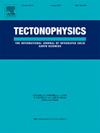长江克拉通地壳结构成像对古代大陆内部变形和地壳再加工的启示
IF 2.7
3区 地球科学
Q2 GEOCHEMISTRY & GEOPHYSICS
引用次数: 0
摘要
环形山多期构造活动的地壳印记为了解大陆演化提供了宝贵的信息。利用两个密集布设、几乎垂直的线性阵列的地震数据,以及新开发的深域接收函数和面波频散联合逐步反演,我们构建了长江克拉通的详细地壳分层模型。我们的分析揭示了拉长的双速度反转带是地壳的显著特征,它可能记录了与新近纪断裂相关的岩浆过程有关的古代地壳再加工和幼年地壳生长。低速和高速构造的相互叠加可能有助于长江克拉通的持久稳定。此外,长江克拉通周围边界带被东倾界面分隔的叠加层和地壳厚度的突然变化,记录了大陆组装期间地壳对大陆内部变形的结构反应。本文章由计算机程序翻译,如有差异,请以英文原文为准。
Insight into intracontinental deformation and crustal reworking of ancient continents implied by crustal structure imaging of the Yangtze Craton
The crustal imprints from multistage tectonic activities in cratons offer valuable insights into continental evolution. Utilizing seismic data from two densely deployed, nearly perpendicular linear arrays, and a newly developed stepwise joint inversion of depth-domain receiver function and surface wave dispersion, we constructed a detailed crustal layering model for the Yangtze Craton. Our analysis revealed elongated double velocity reversal zones as salient features of the crust, which likely record ancient crustal reworking and juvenile crustal growth associated with Neoproterozoic rift-related magmatic processes. The interlayering of low- and high-velocity structures may contribute to the enduring stability of the Yangtze Craton. Additionally, superimposed layers separated by east-dipping interfaces and abrupt changes in crustal thickness in the boundary belts surrounding the Yangtze Craton document the crust's structural responses to intracontinental deformation during continent assembly.
求助全文
通过发布文献求助,成功后即可免费获取论文全文。
去求助
来源期刊

Tectonophysics
地学-地球化学与地球物理
CiteScore
4.90
自引率
6.90%
发文量
300
审稿时长
6 months
期刊介绍:
The prime focus of Tectonophysics will be high-impact original research and reviews in the fields of kinematics, structure, composition, and dynamics of the solid arth at all scales. Tectonophysics particularly encourages submission of papers based on the integration of a multitude of geophysical, geological, geochemical, geodynamic, and geotectonic methods
 求助内容:
求助内容: 应助结果提醒方式:
应助结果提醒方式:


